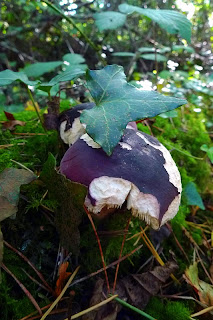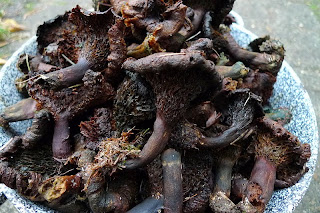We had indeed, as promised, some Indian Summer days recently. The weather is dry since over a week, with some cool nights. But even when the sun is out my garden doesn’t get much of it. The sun is so low now that the old trees around the garden let it in only for a few hours in the afternoon.
This year we had a kestrel pair breeding in one of these nests:
This year we had a kestrel pair breeding in one of these nests:

At this time of the year I like to walk under the trees with my eyes on the forest floor looking out for mushrooms. When I was at that I found another nest in this tree stump here:

It looks to me like a partially destroyed, partially rebuilt wasps’ nest. There were signs of some disturbance around the tree stump. What do others think? I didn’t go too near, as there was still some wasp activity:

I don’t look for mushrooms to eat them. I wouldn’t know which ones are edible, and so many in the books and in reality look very similar, especially those with gills. I know that this one shouldn’t be tried:

There was no sign of it ten days ago, meanwhile several of these have popped up. That’s one of the things that amaze me with mushrooms. How they seem to appear fairly suddenly, stay for a while, and then there’s no sign of the underground organism that produces them again for most of the year.
I also like how searching for them makes you look closely on the forest floor and all that is there, and to walk slowly and carefully so that none that are hidden under and between vegetation and debris get damaged.
I nearly overlooked this one because of its grey colour.
I also like how searching for them makes you look closely on the forest floor and all that is there, and to walk slowly and carefully so that none that are hidden under and between vegetation and debris get damaged.
I nearly overlooked this one because of its grey colour.

I wonder who has found it edible. Like this one:

So, I don’t hunt mushrooms for eating, but I know some mushrooms can be used for dyeing wool. (Especially Cortinarii/Dermocybe types; and Hapalupilus nigulans, which I didn’t find in my book.) In any case, if someone can identify some of the mushrooms here, please let me know.
I tried one type for dyeing, will come to it later. First a few more specimens that I found under the old trees:


The next two are all fairly small.


There were several days between the following two shots. See how this one has overgrown one of the twigs. The pictures were taken from a slightly different position.
Same difference in time here as well (I removed the stick later):


The next two are boletes, that I know:


I got the idea to go into the forestry beside us and see what I would find there. Hadn’t been there for several years. I never liked it and kind of tried to ignore it since it has become very dominant. It was impossible to walk into it when the young trees had started to grow together. Now you can crawl in and when you bend down you can walk around between and under the dry and dead lower branches.

When I had entered I thought I’m in another world. It was really spooky, especially when I remembered what was there before the afforestation. The darkness, which the camera lightened up, and nothing on the ground except needles, needles, needles, and indeed: quite some amount of mushrooms:


The next two are boletes, that I know:


I got the idea to go into the forestry beside us and see what I would find there. Hadn’t been there for several years. I never liked it and kind of tried to ignore it since it has become very dominant. It was impossible to walk into it when the young trees had started to grow together. Now you can crawl in and when you bend down you can walk around between and under the dry and dead lower branches.

When I had entered I thought I’m in another world. It was really spooky, especially when I remembered what was there before the afforestation. The darkness, which the camera lightened up, and nothing on the ground except needles, needles, needles, and indeed: quite some amount of mushrooms:










.jpg)
Lovely pictures - like taking a tour of your local mushrooms! A couple I recognise - Fly agaric obviously, which I think you know too.
ReplyDeleteThen the purpley one - is it a type of russula? And puffballs are the white kind of spiky ones at the edge of the forestry. When they get older and go brown you can squeeze them to see them puff!
I love the fact that a line of mushrooms is called a troop too - there is something so lovely and descriptive about the term. You managed to find some lovely troops!
Hi Snag Breac,
ReplyDeletethanks for your comment. I never heard about the expression you mention: "troops of mushrooms". Interesting!
I think you're right re the russula. My book (German, I admit) has so many russula types, many of which look pretty similar.
If someone knows a good book on Irish mushrooms, or best: a website, please let me know!
There are probably less mushroom species here than on the continent, like with other species?
That would make identification easier I suppose.
I believe there is an Irish website but I don't know what it is. I don't know if this is the one: http://www.wildmushroomsofireland.com/
ReplyDeleteor if it was another - the teacher of the wild mushroom course in Knockvicar mentioned it.
I presume you also know a circle of mushrooms is called a fairy ring? Never fall asleep in one!